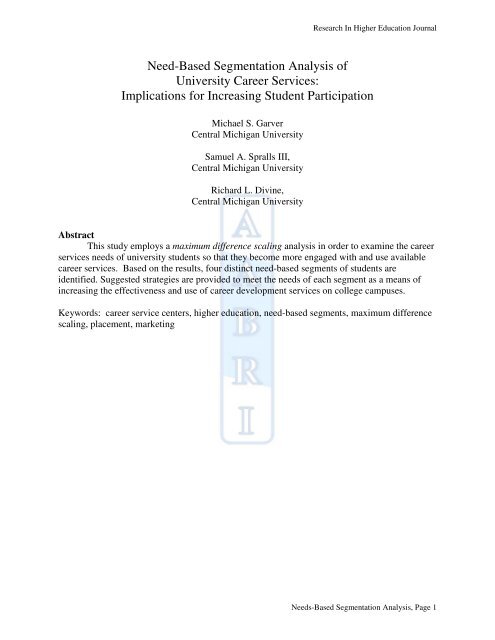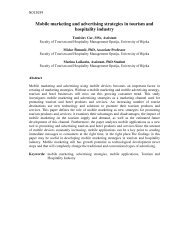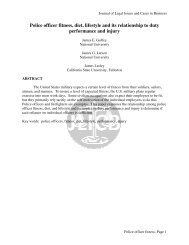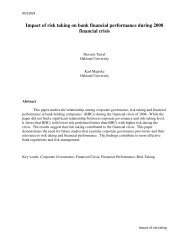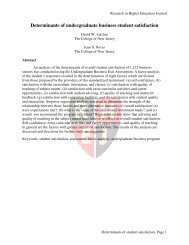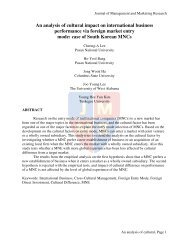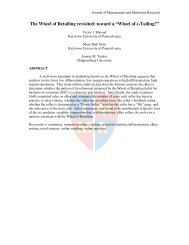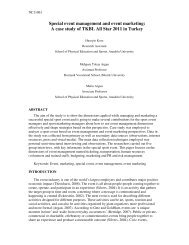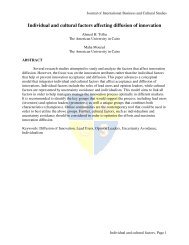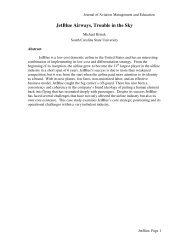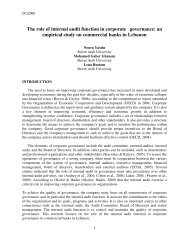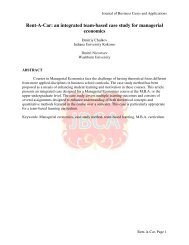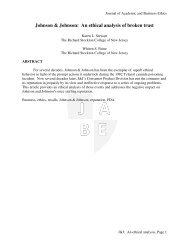Need-Based Segmentation Analysis of University Career Services ...
Need-Based Segmentation Analysis of University Career Services ...
Need-Based Segmentation Analysis of University Career Services ...
Create successful ePaper yourself
Turn your PDF publications into a flip-book with our unique Google optimized e-Paper software.
Research In Higher Education Journal<br />
<strong>Need</strong>-<strong>Based</strong> <strong>Segmentation</strong> <strong>Analysis</strong> <strong>of</strong><br />
<strong>University</strong> <strong>Career</strong> <strong>Services</strong>:<br />
Implications for Increasing Student Participation<br />
Michael S. Garver<br />
Central Michigan <strong>University</strong><br />
Samuel A. Spralls III,<br />
Central Michigan <strong>University</strong><br />
Richard L. Divine,<br />
Central Michigan <strong>University</strong><br />
Abstract<br />
This study employs a maximum difference scaling analysis in order to examine the career<br />
services needs <strong>of</strong> university students so that they become more engaged with and use available<br />
career services. <strong>Based</strong> on the results, four distinct need-based segments <strong>of</strong> students are<br />
identified. Suggested strategies are provided to meet the needs <strong>of</strong> each segment as a means <strong>of</strong><br />
increasing the effectiveness and use <strong>of</strong> career development services on college campuses.<br />
Keywords: career service centers, higher education, need-based segments, maximum difference<br />
scaling, placement, marketing<br />
<strong>Need</strong>s-<strong>Based</strong> <strong>Segmentation</strong> <strong>Analysis</strong>, Page 1
Introduction<br />
Research In Higher Education Journal<br />
One <strong>of</strong> the more notable trends in higher education in recent years has been the<br />
transformation <strong>of</strong> university career services centers (UCSCs) from merely being the coordinators<br />
<strong>of</strong> on-campus placement into full service centers <strong>of</strong> career development (McGrath, 2002;<br />
Patterson, 1995; Rayman, 1999; Snow, 1995; Thompson, 1999). While UCSCs continue to have<br />
primary responsibility for coordinating placement activities, most <strong>of</strong> these centers now also<br />
provide students with a wealth <strong>of</strong> additional career development services. These include: mock<br />
interviews, resume critiquing, informational databases on employers, career counseling,<br />
internship and externship placement assistance, assessment testing, resume books/postings, job<br />
listings and job search training (McCorkle, Alexander, Reardon, & Kling, 2003; McGrath, 2002;<br />
Thompson, 1999).<br />
This expanded menu <strong>of</strong> services has been funded by universities in an effort to make their<br />
students more marketable to employers (McCorkle et al., 2003). This goal is important; not only<br />
in terms <strong>of</strong> helping colleges and universities achieve their mission <strong>of</strong> contributing to the success<br />
<strong>of</strong> their students, but also because an effective career development program will help<br />
postsecondary institutions improve their placement rates (Combs, 2001; Gigliotti, 1994).<br />
Improving this metric is highly desirable because it is <strong>of</strong>ten a key performance indicator in the<br />
strategic plans <strong>of</strong> universities, used by a variety <strong>of</strong> publications as a main criteria in their college<br />
rankings, and many college applicants use placement rates as a measure <strong>of</strong> educational quality<br />
and value (Bednowitz, 2000; Howard-Vital, 2006; Maringe, 2006; McGrath, 2002).<br />
Unfortunately, merely <strong>of</strong>fering career development activities to students does not<br />
guarantee that they will take advantage <strong>of</strong> these opportunities. While these services are essential<br />
to developing “career savvy” students, research suggests that many college students make little<br />
use <strong>of</strong> the services provided by their university’s career center (McCorkle et al., 2003; McGrath,<br />
2002; Patterson, 1995). Obviously, for career development initiatives to be successful, colleges<br />
and universities need to get as many <strong>of</strong> their students as possible to not only register with career<br />
services but to actively participate in the career development activities that are available. To help<br />
achieve this end, a number <strong>of</strong> researchers have recognized the need for career services to be<br />
more effective in marketing their services so that students become more engaged with and<br />
actually use the career development services available to them (Bullock and Brooks, 1994;<br />
McCorkle et al., 2003; Patterson, 1995; Priessler, 1994; Rayman, 1999; Thompson, 1999).<br />
Study Purpose<br />
The purpose <strong>of</strong> this study is to investigate the different underlying needs and preferences<br />
that drive student usage <strong>of</strong> career services. Such an understanding <strong>of</strong> student needs, regarding job<br />
search preparation, can provide a foundation upon which marketing campaigns to increase the<br />
level <strong>of</strong> student participation can be developed.<br />
The methodological approach used in this study seeks to accomplish this purpose by<br />
identifying different need-based segments (i.e., groups <strong>of</strong> students who share a common need<br />
pr<strong>of</strong>ile) and developing specific strategies designed to raise the career services participation rate<br />
within each segment. This segmentation-based approach is consistent with most strategic<br />
marketing frameworks implemented today and avoids the pitfalls associated with viewing a<br />
<strong>Need</strong>s-<strong>Based</strong> <strong>Segmentation</strong> <strong>Analysis</strong>, Page 2
Research In Higher Education Journal<br />
diverse and complex market as a single homogeneous group (Best 2005; St. Clair and Tschirhart,<br />
2007).<br />
This segmentation approach is based on the underlying belief that if the goal is to<br />
increase the career services participation rate <strong>of</strong> students, then a one-size fits all marketing<br />
strategy is unlikely to be effective. To accomplish the study purpose, the following research<br />
questions will be addressed:<br />
• What career services attributes are most important for driving student participation?<br />
• What need-based segments exist and what is their nature?<br />
• What background characteristics describe each segment?<br />
Literature Review<br />
Environmental factors pressuring universities to improve UCSC effectiveness<br />
A number <strong>of</strong> factors within the environment are exerting strong pressure on universities<br />
to improve the effectiveness <strong>of</strong> their career service centers. These factors include: (1) tighter job<br />
markets, (2) more competition among schools for applicants (3) higher tuition and “return on<br />
investment” expectations (4) less on-campus recruiting and (5) volatility in the economy.<br />
Tighter job markets.<br />
Continual increases in the number <strong>of</strong> college graduates combined with a slowing<br />
economy has meant that merely getting a degree does not guarantee students will land a good<br />
paying job (McGrath, 2002). As a result, universities have sought to improve the marketability<br />
<strong>of</strong> their graduates One strategy postsecondary institutions are using to improve student<br />
marketability is to provide them with access to more extensive career development services<br />
(McCorkle et al., 2003). Research suggests that there has been “a paradigm shift in career<br />
services that focuses on the comprehensive delivery <strong>of</strong> services to students for the duration <strong>of</strong><br />
their undergraduate education,” (Nell, 2003, p.184). Failure to provide an effective career<br />
support system could cause universities’ placement results to decline which would put them at a<br />
disadvantage when competing for applications with other universities (McGrath, 2002).<br />
More competition among schools for applicants.<br />
Public and private universities are facing increased competition for applicants from the<br />
influx <strong>of</strong> both for-pr<strong>of</strong>it colleges and on-line and <strong>of</strong>f-campus programs delivered by formerly<br />
out-<strong>of</strong>-market universities (Howard-Vital, 2006). For example, Stokes (2005) forecasted that the<br />
number <strong>of</strong> distance students enrolled in online certificate or degree programs would rise from 1.2<br />
million in 2005 to 1.8 million in 2007. As a result, colleges and universities have had to work<br />
harder in order to maintain enrollment quantity and quality (Domino et al., 2006; Maringe,<br />
2006). Part <strong>of</strong> this effort has been directed toward expanding career development services<br />
because doing so can serve the dual purpose <strong>of</strong> providing benefits that can be promoted to<br />
potential applicants as well as a means for improving placement rates, a metric commonly used<br />
by applicants and their parents as a selection criterion (Harris & Jones, 1999). Additionally, the<br />
need to improve in these areas is further intensified because <strong>of</strong> the entrance <strong>of</strong> new and<br />
“unconventional” competitors. These new sources <strong>of</strong> competition actively promote a more<br />
<strong>Need</strong>s-<strong>Based</strong> <strong>Segmentation</strong> <strong>Analysis</strong>, Page 3
Research In Higher Education Journal<br />
vocational oriented appeal that targets non-traditional students who tend to place higher value on<br />
placement related issues (Howard-Vital, 2006; Veloutsou, Lewis, & Paton, 2004) and expect a<br />
greater return on their educational investment (Harris & Jones, 1999).<br />
Higher tuition and return on investment.<br />
Steadily decreasing government funding for education has forced public colleges and<br />
universities to rely on annual tuition increases in order to balance their budgets (Snow, 1995). As<br />
a result, the cost <strong>of</strong> higher education continues to increase at a rate substantially higher than the<br />
rate <strong>of</strong> inflation (McGrath, 2002). These increased costs have caused applicants and their parents<br />
to not only more strongly consider tuition as a factor in their school choice but also the long term<br />
financial consequences <strong>of</strong> obtaining a particular degree (Harris & Jones, 1999). This means more<br />
consideration is being given to a university’s placement record as applicants try and calculate the<br />
potential financial return on their educational spending (Domino et al, 2006; McGrath, 2002;<br />
Rayman, 1999). Delivering an effective career services program is seen as one way to help<br />
justify the rising costs <strong>of</strong> education.<br />
Less on-campus recruiting.<br />
For reasons <strong>of</strong> cost efficiency, many employers have been cutting back on their oncampus<br />
recruiting (McCorkle et al., 2003; McGrath, 2002; Rayman, 1999; Snow, 1995). As a<br />
result, students have had to become more proactive in their job searches in order to fully exploit<br />
available employment opportunities (McCorkle et al., 2003). Thus, universities have recognized<br />
the need to provide students with more extensive career development training in areas such as<br />
job search skills including resume building, and networking (McCorkle et al., 2003). Maintaining<br />
placement success necessitates that schools get more students to participate in career<br />
development programs that will improve their job search capabilities.<br />
Volatility in the economy.<br />
Increased volatility in the economy due to radical shifts in technology and globalization<br />
have increased the responsibility on universities to prepare their students to enter a work<br />
environment in which they will likely have to change careers multiple times over the course <strong>of</strong><br />
their lifetime (Rayman, 1999). According to Peterson (1995), career counselors estimate that<br />
college graduates will have from three to five careers and eight to ten jobs. To meet this<br />
challenge, postsecondary institutions need to deliver effective career training to as many <strong>of</strong> their<br />
students as possible. These environmental factors have exerted pressure on colleges and<br />
universities to better prepare their students to succeed in an increasingly dynamic and<br />
competitive job market (McCorkle et al., 2003).<br />
Research on Student Usage <strong>of</strong> <strong>Career</strong> <strong>Services</strong> in Higher Education<br />
Previous research has examined a number <strong>of</strong> influences on student usage <strong>of</strong> UCSCs and<br />
strategies for raising participation. Variables such as issues related to the design and use <strong>of</strong> the<br />
WWW and other connecting technologies (e.g., What are “appropriate” career services for a<br />
website?) in UCSCs (Davidson, 2001; Menkh<strong>of</strong>f, Loh, Chiang, & Wah, 2005; Packard, 2003;<br />
<strong>Need</strong>s-<strong>Based</strong> <strong>Segmentation</strong> <strong>Analysis</strong>, Page 4
Research In Higher Education Journal<br />
Sampson, Carr, Panke, Arkin, Minvielle, & Vernick, 2003; Venable, 2007), the effectiveness <strong>of</strong><br />
parents and career services staff jointly motivating students to make use <strong>of</strong> career services<br />
(Harris & Jones, 1999), men’s reasons for and for not seeking career counseling and other<br />
career-related services (Rochlen & O’Brien, 2002), advertising career counseling services to men<br />
(Rochlen, Blazina & Raghunathan, 2002), and stronger UCSC embedding within postsecondary<br />
institutions, e.g., the curriculum model (making career services part <strong>of</strong> course provision) (Watts,<br />
2006).<br />
A study that provides a good illustration <strong>of</strong> both the need for career services and the<br />
problem <strong>of</strong> getting students to participate in UCSCs is McCorkle et al. (2003). These researchers<br />
examined the extent to which marketing students have “self-marketing” skills, i.e. are able to<br />
apply what they have learned about marketing to their own job search process. First, despite their<br />
superior knowledge <strong>of</strong> marketing, they found that marketing majors were no better prepared for<br />
their job search than other business majors. Second, with the exception <strong>of</strong> networking with<br />
potential employers, less than 50% <strong>of</strong> junior students actually participated in available job-search<br />
activities such as seminars on résumé writing, trade or pr<strong>of</strong>essional club organizations and<br />
seminars on job search techniques. Third, seniors, for the most part, were better prepared for job<br />
search than juniors (e.g., many had greater knowledge <strong>of</strong> jobs/career fields) with one notable and<br />
disturbing exception−use <strong>of</strong> career services. The authors found that seniors are using career<br />
services slightly less than juniors. Drawing on interviews and other qualitative data, they<br />
conclude that many senior-level students are “do not consider the career services to be <strong>of</strong> much<br />
assistance,” (McCorkle et al., 2003, p. 202) and most “business schools would likely be appalled<br />
to find the proportion <strong>of</strong> their students who fully use the career development resources at their<br />
career services <strong>of</strong>fices,” (McCorkle et al., 2003, p. 204-5).<br />
In summary, prior studies have focused on ways <strong>of</strong> using information communication<br />
technology to increase the effectiveness and student use <strong>of</strong> UCSCs, gender-specific<br />
psychological reasons for and for not using career services, the treatment effects <strong>of</strong> advertising<br />
brochures, and options for more tightly embedding UCSCs on campuses. What are missing from<br />
the literature are empirical studies that investigate the different underlying needs and preferences<br />
that drive student usage <strong>of</strong> career services.<br />
One exception is Sampson et al., (2003) who examined need-based Internet websites in<br />
career services and thus is particularly relevant to the current study. Their research suggests the<br />
motivation for a website user to continue using a website is based on the degree <strong>of</strong> success a user<br />
has navigating that website for resources and/or services (Sampson et al., 2003). As such they<br />
advocate a website development process focusing more on meeting specific user needs and site<br />
content rather than on application <strong>of</strong> technology. In order to effectively implement this process,<br />
they indicate site designers need to be able to answer the following three questions, “Who should<br />
the website serve? What are the needs <strong>of</strong> the users? What resources are available (or should be<br />
available) to meet user needs?” (Sampson et al., 2003).<br />
Unfortunately, in regards to “who” the website should serve, organizations have a<br />
tendency, for the sake <strong>of</strong> efficient service delivery, to lump their users together (e.g., students,<br />
parents, pr<strong>of</strong>essionals, etc.) based upon some similar characteristic (e.g., age income, occupation,<br />
etc.). Therefore, the organization may not focus on the specific needs <strong>of</strong> specific user groups.<br />
Sometimes an organization is unaware <strong>of</strong> the process by which it distills the complexity <strong>of</strong> the<br />
population they serve into simple categories (Sampson et al., 2003, p. 9). Thus, these authors<br />
advocate the use <strong>of</strong> primary (focus groups, and surveys) and secondary research to help identify<br />
an organization’s users, their needs and the resources needed to satisfy their needs.<br />
<strong>Need</strong>s-<strong>Based</strong> <strong>Segmentation</strong> <strong>Analysis</strong>, Page 5
Research In Higher Education Journal<br />
The current study extends the Sampson et al. (2003) approach by applying it to the<br />
entirety <strong>of</strong> USCSs in general not just USCS websites. Specifically this study seeks to identify<br />
different segments <strong>of</strong> UCSC “customers” based on similarity in need pr<strong>of</strong>ile and then presents<br />
custom-crafted marketing strategies for promoting career services to the members <strong>of</strong> each<br />
segment in order to facilitate increased UCSC participation within each segment.<br />
Research Methodology<br />
The research method seeks to answer the following research questions:<br />
• What career service attributes are most important to students?<br />
• What need-based segments exist and what is their nature?<br />
• What background characteristics describe each segment?<br />
A maximum difference scaling (MDS) web-based survey was administered to a sample<br />
<strong>of</strong> college students. In this section, an overview <strong>of</strong> MDS is provided, followed by a discussion <strong>of</strong><br />
survey design and data collection. After that, the results will be presented.<br />
Maximum Difference Scaling (MDS)<br />
MDS is a new research method that is receiving considerable attention from academic<br />
researchers and practitioners (Chrzan & Golovashkina, 2006; Cohen & Orme, 2004). MDS is an<br />
extension <strong>of</strong> the method <strong>of</strong> paired comparisons. The method <strong>of</strong> paired comparisons has long been<br />
respected as a rigorous research method (Chrzan & Golovashkina, 2006). Whereas paired<br />
comparisons ask for the best choice, MDS asks for both the best and worst choice from a list<br />
containing multiple items. In MDS, the respondent is typically shown 4 or 5 items, with the task<br />
<strong>of</strong> selecting the most preferred/important and least preferred/ unimportant items (see Figure 1, in<br />
Appendix). The respondent is asked to choose the most important and least important items from<br />
the list. As with paired comparison, each respondent is typically asked to evaluate a number <strong>of</strong><br />
choices that are determined using an experimental design plan. MDS requires an experimental<br />
design where each attribute is shown in the exercise a minimum <strong>of</strong> three times, with each<br />
attribute being compared to other attributes each time they are shown to respondents (Orme,<br />
2005).<br />
Many researchers have traditionally used stated importance ratings to measure attribute<br />
importance. To implement this technique, researchers ask survey respondents to rate the<br />
importance <strong>of</strong> each attribute, typically ranging from "not at all important" to "very important."<br />
Although commonly used in practice, this method has major limitations (Garver, 2003). The<br />
most significant limitation is that stated importance ratings <strong>of</strong>ten display a lack <strong>of</strong> discriminating<br />
power between attributes (Cohen & Orme, 2004). Typically, all attributes are “very important” to<br />
customers. Garver (2003) demonstrated, that in prior research, 78% <strong>of</strong> the attributes were "very<br />
important." Cohen (2003) concludes that if most attributes are “very important,” this method is<br />
ineffective at segmentation and research findings are extremely limited. For these reasons, this<br />
common approach was not undertaken.<br />
MDS has a number <strong>of</strong> advantages over traditional research methods. From a researchers’<br />
perspective, the most important advantage is that the data for each attribute typically displays<br />
much higher variance with more discriminating power compared to traditional importance rating<br />
scales. Another advantage <strong>of</strong> MDS is that it captures complicated trade<strong>of</strong>fs in which participants<br />
<strong>Need</strong>s-<strong>Based</strong> <strong>Segmentation</strong> <strong>Analysis</strong>, Page 6
Research In Higher Education Journal<br />
must make difficult choices. Finally, MDS provides ratio data and eliminates scale use bias<br />
(Cohen & Orme, 2004).<br />
Maximum Difference Scaling and <strong>Career</strong> <strong>Services</strong>: Designing the Study<br />
To identify the appropriate attributes for this study, the researchers conducted a literature<br />
review and a qualitative research study. Focus groups were conducted with the target population<br />
to explore relevant attributes to students, which was used to guide survey development.<br />
Focus groups were conducted with career service students to learn the following:<br />
� An in-depth understanding <strong>of</strong> the student experience, in general<br />
� Ways in which they use career service<br />
� Primary reasons for using career service<br />
� Primary reasons for NOT using various career services<br />
To recruit focus group participants, a list <strong>of</strong> students who had use career service was<br />
developed. The students were invited to participate via email. As an incentive, pizza and pop<br />
were provided to students attending the focus group. A total <strong>of</strong> eight students participated in one<br />
focus group. The student sample contained an even number <strong>of</strong> males and females with a variety<br />
<strong>of</strong> different backgrounds and perspectives.<br />
One <strong>of</strong> the researchers moderated the focus group, using an interview guide to help<br />
manage the group, yet the discussions were loosely structured and free flowing. The focus group<br />
began with general background and context style questions. Then, the students were asked<br />
questions concerning the reasons they chose to volunteer and how they got started volunteering.<br />
Probing questions were used to clarify responses and to examine the participant’s perspective in<br />
more detail. (i.e., “Tell me more about that?” or “What exactly do you mean by that?”). The<br />
focus group lasted for 1.5 hours.<br />
The focus group was videotaped, which helped facilitate data analysis. The researchers<br />
watched the focus group a number <strong>of</strong> times, taking detailed notes and using grounded theory<br />
analysis concepts. <strong>Based</strong> on the focus group results, the following key attributes were identified<br />
and used to build the attributes into MDS.<br />
<strong>Based</strong> on the literature review, focus group results, and discussions with <strong>Career</strong> Service<br />
personnel, final attributes were formulated. The MDS web-based survey instrument was then<br />
developed and tested on a convenience sample <strong>of</strong> undergraduate students. The convenience<br />
sample was used to make modifications to the survey. The final survey was posted on a secure,<br />
password protected web site.<br />
A large public Midwestern university supplied the researchers with a database <strong>of</strong> over<br />
9,000 undergraduate students registered with career services. Registered students with career<br />
services were used as the sampling frame because the purpose <strong>of</strong> this study is to examine how to<br />
get students to actually use career services once they were registered. Consistent with findings<br />
from the literature, the UCSC at this university was effective at getting students to register but<br />
not effective in getting students to actually use their services. From this database, 1000 students<br />
were randomly selected to be in the sample. Each student in the sample was invited, by email, to<br />
take the survey and 244 responses were collected, for a response rate <strong>of</strong> 24.4%. While<br />
researchers always want higher response rates, the research team was satisfied with the response<br />
rate. Given the current pressures and continued pressures on survey respondents, the response<br />
rate seems reasonable (Garver, Divine, and Spralls 2009).<br />
<strong>Need</strong>s-<strong>Based</strong> <strong>Segmentation</strong> <strong>Analysis</strong>, Page 7
Results<br />
Importance <strong>Analysis</strong> – Maximum Difference Scaling.<br />
Research In Higher Education Journal<br />
The researchers first cleaned the data for questionable responses. Responses with a fit<br />
statistic below 0.3 were eliminated from the sample. Researchers then used hierarchical Bayes to<br />
analyze the data, providing individual level importance scores ranging from 0 to 100. The total<br />
scores for all attributes sum to 100 with “more important” attributes having higher scores.<br />
When students interact with UCSCs, what attributes are most important to them? Looking at the<br />
overall results in Table 1 (Appendix), we can conclude the following:<br />
• Job acquiring attributes (quality <strong>of</strong> companies to interview with (17.1), provides a variety<br />
<strong>of</strong> different types <strong>of</strong> job opportunities (14.7), and number <strong>of</strong> companies to interview with<br />
(11.1) are critically important to students, taking three <strong>of</strong> the top four spots in regard to<br />
attribute importance.<br />
• Helping students with job search strategies (13.6) is also critically important.<br />
• <strong>Services</strong> that prepare students to acquire the skills and knowledge to obtain a job are<br />
much lower in importance.<br />
• The top nine attributes represent over 77% <strong>of</strong> the importance to students, while the top<br />
four attributes represent approximately 42% <strong>of</strong> the importance.<br />
<strong>Career</strong> <strong>Services</strong> <strong>Need</strong>-<strong>Based</strong> Segments<br />
Examining the overall results can be misleading because different segments may have<br />
different importance values placed on different attributes (Garver, Williams, & Taylor, 2008).<br />
Differences among segments will <strong>of</strong>ten remain hidden when examining overall results.<br />
To answer the second research question, K-means cluster analysis within SPSS was used<br />
to identify segments with similar importance scores. The top nine attributes in importance were<br />
used in the cluster analysis. The analysis suggested that four segments were most appropriate.<br />
Each need-based segment has different needs and is substantial in size (see Table 2, Appendix).<br />
The smallest segment (segment 3) represents 11% <strong>of</strong> the sample, while the largest segment<br />
(segment 2) represents 40% <strong>of</strong> the sample.<br />
Before an in-depth explanation <strong>of</strong> each segment is given, a brief overview will be<br />
provided. Data analysis yielded four distinct segments that we have labeled: placements<br />
(segment 1), best-fit techies (segment 2), unprepareds (segment 3), and high-touches (segment<br />
4). With regard to needs, placements seek a large number <strong>of</strong> high quality companies to interview<br />
with. Best-fit techies are looking for the right job fit using technology-mediated placement<br />
assistance. Unlike, best-fit techies, the unprepareds lack technological readiness and are<br />
primarily concerned with self-development (e.g., job seeking skills and presenting one’s self<br />
effectively) and career education (career seminars and career development courses). Hightouches<br />
are unique in that they have a strong need for one-on-one, on-site interaction or “handholding”<br />
with career services personnel.<br />
Attribute importance difference across segments<br />
Table 3 (Appendix) shows the attributes and their importance scores for each <strong>of</strong> the four<br />
segments. To determine which attributes had a significant impact upon driving segment<br />
<strong>Need</strong>s-<strong>Based</strong> <strong>Segmentation</strong> <strong>Analysis</strong>, Page 8
Research In Higher Education Journal<br />
membership, an ANOVA test was conducted for all <strong>of</strong> the attributes. Results suggest that all nine<br />
variables are highly significant predictors (eight attributes below .01) for determining segment<br />
membership.<br />
Detailed segmentation results<br />
Placements have two critically important attributes and both are directly related to<br />
acquiring a job. “Quality <strong>of</strong> companies to interview with” (42.7) and “number <strong>of</strong> companies to<br />
interview with” (25.7) are the key drivers that define this segment. Displaying lower importance<br />
scores for all other attributes, this segment primarily places importance on getting a job.<br />
Best-fit techies place the highest importance on “provides a variety <strong>of</strong> different types <strong>of</strong><br />
job opportunities” (24.9), with other attributes being aligned in a similar purpose. This segment<br />
places more importance on finding a job that is “right” for them. Supporting this conclusion, they<br />
place significantly more importance on “taking assessment tests to find the right major and<br />
potential job” (8.1) as compared to all other segments. The attribute, “seminars about potential<br />
majors and careers” was not used in cluster analysis to develop segments, yet this segment also<br />
has significantly higher importance scores on this attribute, further suggesting that they are<br />
looking for the right major and type <strong>of</strong> job.<br />
Best-fit techies place significantly more importance on “helpfulness <strong>of</strong> career services<br />
website to research companies” (6.5) and “being notified <strong>of</strong> application deadlines” (5.7). Best-fit<br />
techies place significantly more importance on all attributes related to the career service website<br />
as compared to all other segments.<br />
Unprepareds place the most importance on preparation and developing knowledge and<br />
skills for acquiring a job. The most important attributes for this segment include “usefulness <strong>of</strong><br />
mock interviews” (24.8) and “usefulness <strong>of</strong> resume critiquing services” (21.2). Unprepareds<br />
realize that to land a job, they must first prepare themselves to do well in attracting companies.<br />
High-touches place significantly more importance on “helping Students with job search<br />
strategies” (40.1) than other segments. Indeed, this single attribute has over 40% <strong>of</strong> hightouches’<br />
importance and this segment places significantly more importance on their “interactions<br />
with career service staff” than any other segment.<br />
Describing the need-based segments<br />
This section will examine student perceptions <strong>of</strong> UCSC usage and indicators <strong>of</strong> actual<br />
usage in order to pr<strong>of</strong>ile each segment. Researchers have hypothesized that individual<br />
differences in demographics (i.e., gender, ethnicity, international/domestic status, full-time vs.<br />
part-time), previous experience with UCSCs, and a rough measure <strong>of</strong> Holland Code (see<br />
Holland’s, 1997 theory on personality type and vocational choice) are linked to both individuals’<br />
perceptions and preferences for career services (Shivy & Koehly, 2002).<br />
In contrast, this study found that the majority <strong>of</strong> traditional demographic variables used to<br />
describe student segments provided little help in describing the need-based segments, a<br />
phenomenon the researchers have experienced across a number <strong>of</strong> similar segmentation studies<br />
(Garver, Divine & Spralls, 2009). The best descriptors are students’ own perceptions, along with<br />
actual usage data provided by the university’s career service department. In Table 4 (Appendix)<br />
we provide variables that are all statistically significant descriptors <strong>of</strong> the segments. The two<br />
variables capture student perceptions regarding the extent to which they are career oriented and<br />
<strong>Need</strong>s-<strong>Based</strong> <strong>Segmentation</strong> <strong>Analysis</strong>, Page 9
Research In Higher Education Journal<br />
make use <strong>of</strong> career services. We also provide actual UCSC data (e.g., number <strong>of</strong> interviews and<br />
Web site logins) for comparison.<br />
In the web-based survey, students were asked about their perceptions regarding: 1) their<br />
degree (level) <strong>of</strong> career orientation and 2) the extent to which they use career services. Both <strong>of</strong><br />
these variables are significant descriptive variables <strong>of</strong> the segments. Placements report the<br />
highest level <strong>of</strong> career orientation, while unprepareds see themselves as having the lowest level<br />
<strong>of</strong> career orientation, with the difference representing a statistically significant difference (α =<br />
.01). Concerning perceived career service usage, placements again see themselves as having the<br />
highest level <strong>of</strong> usage with unprepareds having the lowest level <strong>of</strong> usage, with the difference<br />
representing a statistically significant difference (α = .01).<br />
Data regarding the actual usage <strong>of</strong> career services were collected from the focal<br />
university’s career service department. These variables are indicators <strong>of</strong> career service usage<br />
rates including: 1) number <strong>of</strong> website logins to the student’s career service account, 2) number <strong>of</strong><br />
documents (résumés, letters, etc.) that have been posted, 3) number <strong>of</strong> applications for a<br />
requested interview, and 4) number <strong>of</strong> granted interviews. The success ratio variable is the ratio<br />
<strong>of</strong> granted interviews per the number <strong>of</strong> applications for interviews.<br />
After analyzing the actual career service usage data, four themes emerge that shape our<br />
mental models <strong>of</strong> each segment. We find that placements are the “heavy users” while the<br />
unprepareds are “light users” <strong>of</strong> career services. Best-fit techies and high-touches tend to be<br />
“moderate users” with high-touches showing slightly higher usage than best-fit techies.<br />
Two demographic survey questions that help describe these segments include 1) previous<br />
internship experience and 2) college enrollment (see Table 5, Appendix). Consistent with<br />
previous results pertaining to actual usage and career orientation, placements have the highest<br />
percentage <strong>of</strong> internship experience (67%) relative to the other three segments (40% to 45%).<br />
Concerning the relationship between college enrollment and segment type, it is evident<br />
that best-fit techies constitute a rather sizable and consistent presence within all types <strong>of</strong> majors.<br />
Business students are most likely to be placements (42.9%) or best fit techies (38.5%) and are by<br />
far the least likely to be unprepareds (4.4%). Education students are most likely to be best-fit<br />
techies (36.4%) and feature the largest representation <strong>of</strong> high-touches (29.5%), while Arts and<br />
Science majors [Mike: are Arts and Science majors combined at CMU or did you combine<br />
them?] have the highest percentages <strong>of</strong> best-fit techies (44%) and unprepareds (16%) but the<br />
lowest percentage <strong>of</strong> placements (12%).<br />
Implications for Universities<br />
Although there is a plethora <strong>of</strong> research reporting the benefits <strong>of</strong> career services<br />
education and training, with the exception <strong>of</strong> Rochlen et al. (2002), there is little literature<br />
reporting on how these benefits are, or should be, communicated to students. Drawing on<br />
service-learning promotion research, it is likely that marketing by universities <strong>of</strong>fering career<br />
services can influence students’ perceptions <strong>of</strong> UCSC costs (e.g., psychological, time and effort)<br />
and benefits (e.g., increased employability) (St. Clair and Tschirhart, 2007).<br />
The findings <strong>of</strong> St. Clair and Tschirhart (2007) on the Web site promotion <strong>of</strong> servicelearning<br />
programs, leads us to believe that universities’ promotion <strong>of</strong> career services should<br />
center on the benefits that students find attractive instead <strong>of</strong> simply emphasizing aspects <strong>of</strong><br />
UCSCs that career services staff, and/or administrators find appealing.<br />
<strong>Need</strong>s-<strong>Based</strong> <strong>Segmentation</strong> <strong>Analysis</strong>, Page 10
Research In Higher Education Journal<br />
In this section, implications are discussed for universities trying to increase participation<br />
in career services. We describe ways in which knowledge <strong>of</strong> the four major student segment<br />
needs can be used to more effectively market to them. The marketing strategies we recommend<br />
are intended to raise career services participation rates within each segment. In the remainder <strong>of</strong><br />
this section, segment preferences are summarized followed by recruiting and communication<br />
strategies that are put forth for each segment.<br />
Placements<br />
Placements desire a large number <strong>of</strong> interviews with good companies (see Table 3).<br />
Hence, placements may believe that they know what they want and need in order to transition<br />
from the academy to the working world. Following qualitative research by McCorkle et al.<br />
(2003, p. 202) on marketing students, this “perception needs correction as most campus career<br />
services can provide far more than the desired on-campus job interviews, such as company<br />
research sources <strong>of</strong> information; mock interviewing; and skill development seminars on<br />
résumé/cover letter writing, job interviews, and other job search techniques.”<br />
Business students are disproportionately more likely than other students to be placements<br />
(42.9 %) and the vast majority <strong>of</strong> this segment has had one or more internship experiences. An<br />
analysis <strong>of</strong> the data (see table 4) reveals that placements see themselves as more career oriented<br />
and heavy users <strong>of</strong> career services. Behavioral data from our focal UCSC provides support for<br />
this conclusion.<br />
In general, undergraduates tend to prefer time-limited career assistance (Shivy & Koehly,<br />
2002). This may be particularly true for placements (see Table 3) that place far less importance<br />
on: (1) getting help with job search strategies (4.3), (2) taking assessment tests (0.9), (3)<br />
participating in mock interviews (0.7) and (4) having their resume critiqued (1.7).<br />
<strong>Based</strong> on our understanding <strong>of</strong> the needs and preferences <strong>of</strong> placements, they will likely<br />
be responsive to appeals that <strong>of</strong>fer students assistance in developing networking strategies (Shivy<br />
& Koehly, 2002). Simply put, placements may need help building sufficient networks <strong>of</strong> support<br />
(Brown & Krane, 2000). Thus, appeals should focus more on networking-related benefits.<br />
Placements Strategy: Promote Networking Opportunities<br />
There is evidence to support the notion that the philosophical orientation <strong>of</strong> UCSCs has<br />
shifted from “placement” toward networking (Baker, 1998; Casella, 1990; Wessel, 1996).<br />
Networking, a non-traditional type <strong>of</strong> mentoring, has been suggested as a replacement for the<br />
traditional model <strong>of</strong> dyadic mentoring (Packard, 2003). Networking has been called the most<br />
powerful vehicle in making the transition from the academy to the work force (Casella, 1990;<br />
Wessel, 1996). Indeed, more than 30 percent <strong>of</strong> the respondents in a recent survey <strong>of</strong> UCSC<br />
directors stated that the rationale for their department’s existence was “connecting students with<br />
employers” (Wessel, 1996). As indicated by Peterson (1995), as much as 80% <strong>of</strong> all jobs are<br />
obtained through personal contacts. The ultimate goal for UCSCs should be to foster an<br />
independent networking orientation in these students (Scott, 1983).<br />
According to Brooks (1996), a networking orientation can be accomplished in at least<br />
three important ways. First, the UCSC should forge links between faculty and potential<br />
employers. Second, the UCSC should engage in on-campus college relations activities (e.g.,<br />
<strong>of</strong>fering company information sessions). Third, the UCSC should <strong>of</strong>fer and promote <strong>of</strong>f-campus<br />
<strong>Need</strong>s-<strong>Based</strong> <strong>Segmentation</strong> <strong>Analysis</strong>, Page 11
Research In Higher Education Journal<br />
college relations activities (e.g., internships, externships, and, <strong>of</strong> course, full-time job openings).<br />
Other networking strategies include (1) establishing mentoring relationships (both face-to-face<br />
and technology-mediated, Packard, 2003) and then expanding into a personal network (Baker,<br />
1998), and (2) relying on parents to identify possible contacts for their children as well as the<br />
children <strong>of</strong> others (Harris & Jones, 1999).<br />
Our secondary strategy is to raise each group’s perception <strong>of</strong> UCSC relevance (Rayman,<br />
1999). Student that perceive UCSC services as relevant are more likely to use the services<br />
(Nadya, Guillen, Harris-Hodge, Henry, Novakovic, Terry, & Kantamneni, 2006). Because there<br />
are so many alternatives (e.g., students can attempt to find their own jobs, or use competing<br />
services) simple repetition <strong>of</strong> marketing messages is necessary but insufficient to make the<br />
UCSC stand for something significant to placements. This requires communication strategies<br />
that portray UCSC services in a meaningful way to placements. For example, Rochlen et al.<br />
(2002) found that gender-specific brochures may change men’s attitudes toward career<br />
counseling and increase the perceived value <strong>of</strong> career services and decrease stigmas that may be<br />
attached. Perhaps, placements and best-fit techies can be reached through new and rapidly<br />
growing social networking sites such as myspace.com and facebook.com, which we discuss in<br />
more detail in the next section.<br />
Best-fit Techies<br />
Best-fit techies are mostly concerned with being able to evaluate a lot <strong>of</strong> good job<br />
opportunities (24.9), and getting help with job search strategies (7.0) in order to select the best<br />
“job fit” (8.1). <strong>Based</strong> solely on student attribute importance scores, we argue, that this group,<br />
unlike the others, has a preference for online job search (6.5), and being notified <strong>of</strong> job postings<br />
and application deadlines through electronic means (5.7). Previous research on online delivery <strong>of</strong><br />
career services has examined online/<strong>of</strong>fline integration (i.e., bricks and clicks strategies) (e.g.,<br />
Venable, 2007), the unique needs <strong>of</strong> some men (e.g., Rochlen & O’Brien, 2002), the unique<br />
needs <strong>of</strong> some women (e.g., Packard, 2003), and the advantages/disadvantages <strong>of</strong> online service<br />
delivery and critical issues that should be considered (e.g., Davidson, 2001).<br />
The research on advantages and disadvantages <strong>of</strong> career interventions online is<br />
particularly relevant to this study. For Davidson (2001), the overarching advantage <strong>of</strong> career<br />
services via the Web is convenience. For students, this includes: any-time/any-place options,<br />
ownership <strong>of</strong> the process, and direct access to information while “bypassing the UCSC front<br />
desk.” Researchers have found that these advantages could make it easier for UCSCs to reach<br />
men and women who may be unable or unwilling to seek out more traditional (i.e., walk-in)<br />
career counseling services (Packard, 2003; Rochlen & O’Brien, 2002). Beyond obvious concerns<br />
for privacy and confidentiality, one potential disadvantage to UCSCs <strong>of</strong> using the Web is the<br />
difficulty <strong>of</strong> tailoring services to individual needs (Davidson, 2001). We, like Davidson (2001),<br />
find that not all students have the same needs.<br />
Packard (2003) reports the usefulness UCSCC virtual chat rooms and compares them to<br />
long-distance counselors. By extension, today’s students would likely be comfortable with online<br />
resume posting see Athavaley, WSJ 12/6/06, “Posting Your Résumé on YouTube”), job<br />
application and possibly interviewing. Additionally, many students have created an avatar (one’s<br />
virtual world persona) and participated in interviews in virtual worlds (e.g., secondlife.com) with<br />
companies such as Micros<strong>of</strong>t and others (see Athavaley, WSJ, 6/20/07, “A Job Interview You<br />
Don’t Have to Show Up For”). <strong>Based</strong> on their stated importance scores and empirical data from<br />
<strong>Need</strong>s-<strong>Based</strong> <strong>Segmentation</strong> <strong>Analysis</strong>, Page 12
Research In Higher Education Journal<br />
extant research, this group is likely interested in conducting online job searches at Web sites such<br />
as MonsterTrak.com, a national job listing service for colleges and universities (<strong>University</strong> <strong>of</strong><br />
California Santa Cruz Annual Report, 2004).<br />
Going beyond online delivery preferences, we find descriptive statistics indicating that<br />
best-fit techies are the largest segment, light to moderate users <strong>of</strong> traditional career services (e.g.,<br />
walk-in access to counseling) and are fairly equally distributed across all types <strong>of</strong> majors. Thus,<br />
it is important that UCSCs utilize the Internet (and possibly extranets) to reach this segment,<br />
thereby, freeing staff time for tasks that require human interaction (Rayman, 1999).<br />
Best-fit Techies Strategy: Use E-Marketing<br />
The digerati (those that are savvy regarding digital technologies) that comprise this group<br />
prefer the use <strong>of</strong> electronic networks to deliver career services (Behrens & Altman, 1998;<br />
Davidson, 2001) and information in a variety <strong>of</strong> formats (e.g., podcast and text message). Howe<br />
and Strauss (2003, p. 81), put it this way “millennial generation students expect to use<br />
technology and have the tools necessary to “streamline their educational experience.” Because<br />
research shows that this segment (44% <strong>of</strong> whom are likely liberal arts majors, see Nell, 2003) has<br />
high usage rates for Internet related media (see “Buddy Can You Spare Some Time?” Wall<br />
Street Journal January 26 th , 2004), the following strategies and tactics are suggested:<br />
• drive traffic to the UCSC Web site − even at the expense <strong>of</strong> walk-in traffic<br />
(Davidson 2001) to expose students to targeted communications<br />
• design career-themed “blogs” (online diaries) to appeal to students in this segment<br />
• recruit newly hired students to post videos (and other user-generated content) on<br />
sites such as youtube.com (see White, WSJ 1/2/07, “Firms Take a Cue From<br />
YouTube”)<br />
• enable employers to initially screen student applicants in virtual career fairs<br />
(Steel, WSJ 10/23/07, “Marketers Explore New Virtual Worlds”)<br />
• consider building and maintaining “career communities” (e.g., utilizing the<br />
groups, events and market features in facebook.com)<br />
• allow students to register at UCSC Web sites to have text messages sent to their<br />
cell phones notifying them that employers will be on campus<br />
Despite this abundance <strong>of</strong> opportunities, in a recent study by Nadya et al. (2006), only 34% <strong>of</strong><br />
students were even aware <strong>of</strong> the UCSC Web site despite it being linked to the urban university’s<br />
homepage. Clearly, many UCSCs are unprepared to meet the information needs <strong>of</strong> best-fit<br />
techies.<br />
Unprepareds<br />
The unprepareds are primarily seeking career education and self-development (see Table 3).<br />
Although they are the smallest <strong>of</strong> the four segments (see Table 2), they require innovative and<br />
well thought out appeals to reach them. A careful review <strong>of</strong> the data (see Table 4) reveals that<br />
they have:<br />
• lowest level <strong>of</strong> perceived career orientation and usage <strong>of</strong> career services (4.14 and 1.77)<br />
• a poor success ratio for job interviews (0.10)<br />
• lowest number <strong>of</strong> actual applications (0.64)<br />
• lowest number <strong>of</strong> web site logins (28.86)<br />
<strong>Need</strong>s-<strong>Based</strong> <strong>Segmentation</strong> <strong>Analysis</strong>, Page 13
Research In Higher Education Journal<br />
However, to get the real story on unprepareds, one has to examine what they are not<br />
seeking (see Table 3). Unlike placements, they are not ready to interact with large numbers <strong>of</strong><br />
quality companies (1.9, 4.2). Unlike best-fit techies, they do not consider being able to find<br />
company/job information on the UCSC web site <strong>of</strong> importance (1.2) and they place little<br />
importance on seeing a variety <strong>of</strong> different job opportunities (2.7). They have low perceived<br />
career orientation and usage <strong>of</strong> career services (4.14 and 1.77).<br />
<strong>Based</strong> our analysis <strong>of</strong> what unprepareds are seeking and not seeking, we conclude that<br />
they are lacking in job search skills. McCorkle (2003, p. 199), like Nell (2003), argues that job<br />
search skills “represent a skill set area whose development has long been neglected in many<br />
college curriculums.” As evidenced by their importance scores, this group should respond well to<br />
having career services training and skills development integrated into the curriculum (Falconer<br />
and Hays, 2006).<br />
Unprepareds Strategy: Make <strong>Career</strong> <strong>Services</strong> Part <strong>of</strong> the Curriculum<br />
Obviously, this group should find increased opportunities for career education and selfdevelopment<br />
appealing. Research suggests that African American students, much like<br />
unprepareds, have low usage <strong>of</strong> career services. Indeed, “it is commonly known that ethnic<br />
minority students on predominantly White campuses have traditionally underused career<br />
services,” (Falconer & Hays, 2006, p.220). It is important to note that we are not saying that<br />
unprepareds are largely African American, only that the experiences <strong>of</strong> African Americans with<br />
UCSCs informs our research.<br />
One finding is particularly relevant to this study, that is, Falconer & Hays (2006) found<br />
student support for making job preparatory courses mandatory. Thus, by extension, colleges and<br />
universities should consider including career services education (including discipline-related<br />
skills (e.g., segmentation strategy) and support skills (e.g., decision-making) in the curriculum.<br />
Support for these ideas is developed in the following paragraphs.<br />
The European-based Harris Committee (2001, p. 15) reports that the prime function <strong>of</strong><br />
higher education careers services should be “to help the institution produce better-informed<br />
students who are self-reliant, able to plan and manage their own learning and have sound career<br />
management skills.” Furthermore, they advocate that career services “have key roles in<br />
delivering, or helping tutors to deliver, aspects <strong>of</strong> the curriculum, for example relating to the<br />
development <strong>of</strong> student’s career management skills, arranging work experience and encouraging<br />
students to reflect on that experience (p.30).<br />
There is U.S. support for embedding career services education in the curriculum <strong>of</strong><br />
colleges and universities as well (Nell, 2003). McCorkle et al. (2003), define job search skills as<br />
behaviors, techniques, and attitudes necessary to obtain employment. McCorkle et al. (2003),<br />
conclude that marketing and possibly business courses in general, should in addition to<br />
traditional course content, include behavioral learning skills. For example, freshmen and<br />
sophomores might be required to identify marketable career skills by writing down work-related<br />
discipline skills.<br />
In regard to self-development, one <strong>of</strong> the most important ways to attract unprepareds is<br />
to <strong>of</strong>fer to help them sell themselves in the job interview. <strong>Based</strong> on unprepareds’ poor success<br />
ratio for job interviews, as well as empirical observations <strong>of</strong> the authors, it is reasonable to<br />
conclude that this group would benefit from learning metacommunication behaviors such as eye<br />
contact, firm handshake, and appropriate business attire (McCorkle et al., 2003). Furthermore,<br />
<strong>Need</strong>s-<strong>Based</strong> <strong>Segmentation</strong> <strong>Analysis</strong>, Page 14
Research In Higher Education Journal<br />
this group would likely be interested in proven techniques for dealing with rejection (e.g.,<br />
sending a carefully written thank you letter in order to qualify for future consideration)<br />
(McCorkle et al., 2003). Our fourth segment, the high-touches, should also respond well to<br />
targeted <strong>of</strong>fers <strong>of</strong> help with job search strategies.<br />
High-touches<br />
Clearly, high-touches place the most importance (40.4) on getting help with job search<br />
strategies. They likely do not believe that they can devise an effective job search strategy on their<br />
own. Although they see themselves as being career oriented (4.43) they may be at a loss to<br />
explain why they have had difficulty in landing jobs. We conclude that they are having little<br />
success at finding a job because <strong>of</strong> (see Table 4) their relatively low success ratios for interviews<br />
(.01). It simply follows, then, that high-touches are moderate users <strong>of</strong> career services and seek<br />
tailored job search strategies and one-on-one interaction with UCSC personnel.<br />
High-Touches Strategy: Tailor Appeals to Stages <strong>of</strong> <strong>Career</strong> Decision-Making and Major<br />
Morgan and Ness (2003) argue that career counseling programming should be tailored<br />
more effectively to the career decision-making needs <strong>of</strong> first-year students to lessen career<br />
decision-making difficulties. For example, first-year university students ask career counselors<br />
and other service pr<strong>of</strong>essionals things like: What career should I take? In a similar vein,<br />
McCorkle et al. (2003) found that junior marketing majors “most used job searches” differed<br />
from that <strong>of</strong> seniors. For example, seniors most used sources included “past and/or present<br />
employers, whereas juniors did not. Furthermore, research has shown that liberal arts and<br />
business majors have very different needs (McCorkle et al., 2003; Nell, 2003). Clearly, the<br />
literature suggests that students needing help with job search strategy and desiring one-to-one<br />
interaction, such as our high-touches, should respond well to carefully targeted and highly<br />
customized appeals.<br />
To address the information (and understanding) needs <strong>of</strong> high-touches, UCSCs should<br />
provide more information about various stages <strong>of</strong> career decision-making and corresponding<br />
UCSC services <strong>of</strong>fered. In this way, the process does not seem so daunting and is more akin to<br />
“hand-holding,” (Nadya et al., 2006). Additionally, communications could reduce high-touches’<br />
uncertainty about the process or steps involved in ultimately landing the “dream” job. UCSCs<br />
should also provide more information about services that are targeted at various developmental<br />
levels. For example, freshmen and sophomores are likely to be more interested in services that<br />
help them decide on the right major while seniors and graduate students would be more<br />
interested in receiving information related to their job search (McCorkle et al., 2003; Morgan &<br />
Ness, 2003).<br />
Finally, research suggests the effectiveness <strong>of</strong> college-specific career services appeals.<br />
For example, Nell (2003) finds that “many Arts and Science students have to create their own<br />
career focus because their academic degree and acquired skills can be used in a variety industries<br />
and positions,” (sic). The authors suggest a career services curriculum component and carefully<br />
planned Web site use to address some <strong>of</strong> these issues. For example, the <strong>University</strong> <strong>of</strong> Missouri at<br />
Columbia has a course named “Transitions from College to Work,” (Nell, 2003). McCorkle et al.<br />
(2003), in their study <strong>of</strong> marketing students, recommend that colleges <strong>of</strong> business start selfmarketing<br />
instruction early (e.g., in the Principles <strong>of</strong> Marketing course), and strengthen ties with<br />
<strong>Need</strong>s-<strong>Based</strong> <strong>Segmentation</strong> <strong>Analysis</strong>, Page 15
Research In Higher Education Journal<br />
career services (e.g., satellite UCSC <strong>of</strong>fices) and stronger promotion <strong>of</strong> pr<strong>of</strong>essional<br />
clubs/associations.<br />
Limitations<br />
As a research limitation, the segments identified in this study may not be applicable to<br />
undergraduate students in other universities. Furthermore, the sample is more likely to get<br />
involved in career services based on their participation for this survey, which makes our sample<br />
more likely to be different from the overall population at the study university. Thus, to generalize<br />
more to the population <strong>of</strong> undergraduate students, larger samples drawn from a larger cross<br />
section <strong>of</strong> universities will be necessary. Replications <strong>of</strong> the study methodology at other<br />
campuses is needed before the presence <strong>of</strong> the four need based segments uncovered in the<br />
current study can be scientifically generalized.<br />
As indicated herein, the purpose <strong>of</strong> this study was to examine student needs so that<br />
UCSCs could be more effective in getting students to actually use their services. Thus, students<br />
in this sample were already registered with the UCSC. Future research may want to examine the<br />
needs <strong>of</strong> students who are not registered with career services.<br />
Final Conclusions<br />
This study responds to the call by Nadya et al. (2006) to investigate factors that may<br />
facilitate or hinder students from using career services. The results <strong>of</strong> the study indicate not all<br />
individuals are interested in getting the same things from career services. Student importance<br />
scores for participating in career services were analyzed and four distinct need-based segments<br />
were indentified.<br />
Specifically, it was discovered that students classified as placements are likely to be<br />
business majors, have the highest levels <strong>of</strong> career orientation, career services usage, and<br />
internship experience. Although placements believe that all they need are a large number <strong>of</strong> high<br />
quality companies to interview with, our study finds that that this group needs to see UCSCs as<br />
relevant. Additionally, this group should respond well to appeals <strong>of</strong>fering help with networking<br />
strategies despite their apparent naiveté.<br />
In contrast, best-fit techies want the job that is “right for them” but they want to be able<br />
to use the Internet and other connecting technologies in their job search efforts. They are<br />
moderate users <strong>of</strong> UCSCs, well represented across all majors, especially Arts and Science. Emarketing<br />
may be a key to getting this group to participate.<br />
Unprepareds are least likely to be business students, have the lowest level <strong>of</strong> career<br />
orientation and the lowest level <strong>of</strong> UCSC usage. In general, unprepareds are unsure how to<br />
proceed with job search strategies. They both seek and need self-development and career<br />
education. This group will likely welcome the addition <strong>of</strong> one credit hour classes on job search<br />
skills to the curriculum.<br />
Finally, high-touches are moderate users <strong>of</strong> career services, and actually prefer significant<br />
one-on-one interaction with career counselors and staff. To increase the participation <strong>of</strong> this<br />
group, colleges and universities should <strong>of</strong>fer one-to-one interaction with UCSC staff and<br />
pr<strong>of</strong>essionals and consider tailoring appeals to student class year, major and type <strong>of</strong> college.<br />
It is not necessarily recommended that universities attempt to target all four segments.<br />
Which segment a school targets will primarily be a function <strong>of</strong> their mission and their budget<br />
<strong>Need</strong>s-<strong>Based</strong> <strong>Segmentation</strong> <strong>Analysis</strong>, Page 16
Research In Higher Education Journal<br />
situation. Universities whose main objective is just to get more students more involved in career<br />
services would likely want to focus their efforts on unprepareds, best-fit techies and hightouches,<br />
because these are the segments most likely to yield them more “new and repeat<br />
business” for their services. On the other hand, schools who view their mission one <strong>of</strong> increasing<br />
the overall employability <strong>of</strong> all students may want to focus their efforts on reaching out to those<br />
students who may be less interested but likely most in need <strong>of</strong> job skills training (e.g.,<br />
placements).<br />
This research has identified and described four need-based segments <strong>of</strong> career services<br />
users and presented a set <strong>of</strong> customized marketing strategies designed to increase student<br />
participation within each segment. This research extends the literature on career services usage<br />
and may serve to improve the effectiveness <strong>of</strong> career services practice. By providing a better<br />
understanding <strong>of</strong> student needs, this research should allow colleges and universities to<br />
specifically target the groups identified in this study, increase their participation with career<br />
services, thereby, helping their graduates to develop the behaviors, techniques, and attitudes<br />
necessary to obtain employment.<br />
References<br />
Athavaley, Anjali (2007). A job interview you don’t have to show up for. Wall Street Journal,<br />
June 20 Front.<br />
Athavaley, Anjali (2006). Posting your résumé on YouTube. Wall Street Journal, December 6<br />
D1.<br />
Baker, Gregory A. (1998). The development <strong>of</strong> a mentor program to foster career management.<br />
International Food & Agribusiness Management Review, 1(2), 259-269.<br />
Bednowitz, Ian. (2000). The impact <strong>of</strong> the Business Week and U.S. News & World Report<br />
rankings on the business schools they rank. ERIC number ed481757.<br />
Behrens, Troy and Brian Altman (1998). Technology: Impact on and implications for college<br />
career centers. Journal <strong>of</strong> <strong>Career</strong> Planning & Employment, 58 (2) 19-24.<br />
Best, Roger (2005). Market-<strong>Based</strong> Management: Strategies for Growing Customer Value and<br />
Pr<strong>of</strong>itability. Upper Saddle River, New Jersey, Fourth Edition, Prentice Hall.<br />
Brooks, Jennifer E. (1996). Multifaceted relationships benefit career services <strong>of</strong>fices and<br />
employer recruiters. The Journal <strong>of</strong> <strong>Career</strong> Planning & Employment, 57 (1) 61-64.<br />
Brown, S.D., and N.E.R. Krane (2000). Four (or five) sessions and a cloud <strong>of</strong> dust: Old<br />
assumptions and new observations about career counseling. In S. Brown & R. Lent<br />
(Eds.), Handbook <strong>of</strong> Counseling Psychology, 3 RD ed., 740-766, NY: Wiley.<br />
Bullock Marcy, and Jennifer E. Brooks (1994). An essential job: Marketing the placement <strong>of</strong>fice<br />
to faculty and employers. Journal <strong>of</strong> <strong>Career</strong> Planning and Employment, 54 (2) 28-31.<br />
Casella, D.A. (1990). <strong>Career</strong> networking-the new career center paradigm. Journal <strong>of</strong> <strong>Career</strong><br />
Planning & Employment, 50 (4) 32-39.<br />
Chrzan K. & Golovashkina N. (2006). An empirical test <strong>of</strong> six stated importance measures.<br />
International Journal <strong>of</strong> Marketing Research, 48 (6).<br />
Cohen, S. (2003). Maximum difference scaling: improved measures <strong>of</strong> importance and<br />
preference for segmentation. Proceedings <strong>of</strong> the 2003 Sawtooth S<strong>of</strong>tware Conference,<br />
San Diego, CA, 61-74.<br />
Cohen, S. & Orme B. (2004). What's your preference? Marketing Research, 16 (Summer 2004),<br />
32-37.<br />
<strong>Need</strong>s-<strong>Based</strong> <strong>Segmentation</strong> <strong>Analysis</strong>, Page 17
Research In Higher Education Journal<br />
Combs, Michelle (2001). Job placement services: Grooming students for career success, Tech<br />
Directions. 61(2) 21-25.<br />
Davidson, Meghan M. (2001). The computerization <strong>of</strong> career services: critical issues to consider.<br />
Journal <strong>of</strong> <strong>Career</strong> Development, 27(3), 217-228.<br />
Domino, Stefanie , Danielle Lutwiller, Shannon Superczynski, Robert Tian & Teresa Libraire<br />
(2006). Higher education marketing concerns: Factors influence students' choice <strong>of</strong><br />
colleges, The Business Review, 6(2), 101-111.<br />
Falconer, Jameca W. & Hays, Kimberly A. (2006). Influential factors regarding the career<br />
development <strong>of</strong> African American college students. Journal <strong>of</strong> <strong>Career</strong> Development,<br />
32(3), 219-233.<br />
Garver, M.S. (2003). Customer-driven improvement model: Best practices in identifying<br />
improvement opportunities. Industrial Marketing Management, 32 (6) 455-466.<br />
Garver, M.S., Williams, Z. & Taylor, S. (2008). Employing latent class regression analysis to<br />
examine logistics theory: An application <strong>of</strong> truck driver retention. Journal <strong>of</strong> Business<br />
Logistics, forthcoming.<br />
Garver, Michael S., Richard L. Divine and Samuel A. Spralls III (2009). <strong>Segmentation</strong> analysis<br />
<strong>of</strong> the volunteering preferences <strong>of</strong> university students. Journal <strong>of</strong> Nonpr<strong>of</strong>it and Public<br />
Sector Marketing, 20 (2).<br />
Gerhard, Julia & Mayr, Peter (2002). Competing in the e-learning environment-strategies for<br />
universities. Proceedings <strong>of</strong> the 35 th Hawaii International Conference on System<br />
Sciences.<br />
Gigliotti, Peter M (1994). A career center is centered on campus. Journal <strong>of</strong> <strong>Career</strong> Planning &<br />
Employment 54(2) 6-7Hammond, Marie S. (2001). <strong>Career</strong> centers and needs<br />
assessments: Getting the information you need to increase your success. Journal <strong>of</strong><br />
<strong>Career</strong> Development, 27 187-197.<br />
Harris Committee (2001). Developing modern higher education careers services. Review chaired<br />
by Sir Martin Harris. London: Department <strong>of</strong> education & Employment.<br />
Harris, Marcia B. and Sharon L. Jones (1999). Parents as partners: allies in promoting and<br />
supporting career services. NACE Journal <strong>of</strong> <strong>Career</strong> Planning and Employment, Winter,<br />
29-31, 47-48.<br />
Holland, J., (1997). Making vocational choices: A theory <strong>of</strong> vocational personalities & work<br />
environments (3 rd ed.). Odessa, FL: Psychological Assessment Resources.<br />
Howard-Vital, Michelle (2006). The appeal <strong>of</strong> for-pr<strong>of</strong>it institutions. Change, 38 (1) 68-71.<br />
Howe, N. & Strauss, W. (2003). Millennials go to college. Life Course Associates & the<br />
American Association <strong>of</strong> Collegiate Registrars & Admission Officers.<br />
Maringe, Felix (2006). <strong>University</strong> and course choice: Implications for positioning, recruitment<br />
and marketing. The International Journal <strong>of</strong> Educational Management, 20 (6) 466-479.<br />
McCorkle, Denny E., Alexander, Joe F., Reardon, James, & Kling, Nathan D. (2003).<br />
Developing self-marketing skills: are marketing students prepared for the job search?<br />
Journal <strong>of</strong> Marketing Education, 25(3), 196-207.<br />
McGrath, Gary L., (2002). The emergence <strong>of</strong> career services and their important role in working<br />
with employers. New Directions for Student <strong>Services</strong>, 100 69-85.<br />
Menkh<strong>of</strong>f, Thomas, Loh, Benjamin, Chiang, Ruth, Waj, Chay Yue (2005). Knowledge<br />
management as an enabler <strong>of</strong> effective career services in institutions <strong>of</strong> higher learning:<br />
the case <strong>of</strong> the Singapore management university. International Journal Human<br />
Resources Development & Management, 5(2), 204-216.<br />
<strong>Need</strong>s-<strong>Based</strong> <strong>Segmentation</strong> <strong>Analysis</strong>, Page 18
Research In Higher Education Journal<br />
Morgan, Tracy, & Ness, David (2003). <strong>Career</strong> decision-making difficulties <strong>of</strong> first-year students.<br />
The Canadian Journal <strong>of</strong> <strong>Career</strong> Development, 2, 33-37.<br />
Nadya, Fouad A., Amy Guillen, Elizabeth Harris-Hodge, Caroline Henry, Alexandra Novakovic,<br />
Sarah Terry and Neeta Kantamneni (2006). <strong>Need</strong>, awareness, and use <strong>of</strong> career services<br />
for college students. Journal <strong>of</strong> <strong>Career</strong> Assessment, 14 407-420.<br />
Nell, Amanda E. (2003). The good, the bad, and the ugly: developing placement services for<br />
liberal arts undergraduates. Journal <strong>of</strong> <strong>Career</strong> Development, 29(3), 183-194.<br />
Packard, Becky Wai-Ling (2003). Web-based mentoring: challenging traditional models to<br />
increase women’s access. Mentoring & Tutoring, 11(1), 53-65.<br />
Patterson, Valerie (1995). Whose job is it to interest students in careers? Journal <strong>of</strong> <strong>Career</strong><br />
Planning & Employment, 55(4), 6-8.<br />
Peers, Martin (2004). Buddy, can you spare some time? The Wall Street Journal, January 26,<br />
B1.<br />
Peterson, L. (1995). Starting Out, Starting Over. Palo Alto, CA: Davies-Black.<br />
Priessler, Scott (1994). Building a powerful <strong>of</strong>fice image on campus. Journal <strong>of</strong> <strong>Career</strong><br />
Planning & Employment, 54(2), 32-35.<br />
Rayman, Jack R. (1999). <strong>Career</strong> services imperatives for the next millennium. <strong>Career</strong><br />
Development Quarterly, 48 (2) 175-184.<br />
Rochlen, Aaron B., & O’Brien, Karen M. (2002). Men’s reasons for and against help for careerrelated<br />
concerns. Journal <strong>of</strong> Men’s Studies, 11(1), 55-63.<br />
Rochlen, Aaron B., Blazina, Christopher, Raghunathan, Rajagopal (2002). Gender role conflict,<br />
attitudes toward career counseling, career decision-making, & perceptions <strong>of</strong> career<br />
counseling advertising brochures. Psychology <strong>of</strong> Men & Masculinity, 3(2), 127-137.<br />
Sampson, James P., Carr, Darrin L., Arkin, Scott, Minvielle, Meagan, Vernick, Stacie H. (2003).<br />
Design strategies for need-based Internet web sites in counseling & career services<br />
technical report number 28. Center for the Study <strong>of</strong> Technology in Counseling & <strong>Career</strong><br />
Development, Florida State <strong>University</strong>.<br />
Scott, G. J. (1983). The <strong>Career</strong> planning and placement <strong>of</strong>fice: Implications for the future.<br />
Bethlehem, PA: College Placement Council Foundation.<br />
Shivy, Victoria A. and L.M. Koehly (2002). Client perceptions <strong>of</strong> and preferences for<br />
university-based career services. Journal <strong>of</strong> Vocational Behavior, 60 40-60.<br />
Snow, Tom (1995). Oxford takes a look at career services over here. Journal <strong>of</strong> <strong>Career</strong><br />
Planning & Employment, 55(4) 32-34.<br />
St. Clair, Lynda & Tschirhart, Mary (2007). Service-Learning Programs: What are universities<br />
selling to students? Journal <strong>of</strong> Nonpr<strong>of</strong>it & Public Sector Marketing, 18(1), 37-55.<br />
Steel, Emily (2007). Marketers explore new virtual worlds. Wall Street Journal, October 23 B9.<br />
Stokes, P. J. (2005). Hidden in plain sight: Adult learners forge a new tradition in higher<br />
education. Issue Paper: The Secretary <strong>of</strong> education’s Commission on the Future <strong>of</strong><br />
Higher education. Retrieved January 30, 2009, from<br />
http://www.ed.gov/about/bdscomm/list/hiedfuture/reports/stokes.pdf.<br />
Thompson, J. J. (1999). <strong>Career</strong> services with a smile. ASEE Prism, 9 (3) 31-32.<br />
<strong>University</strong> <strong>of</strong> California Santa Cruz Annual Report (2003-2004). <strong>Career</strong> Center Mission<br />
Statement Goals Program Highlights & Statistics. November.<br />
Veloutsou, Cleopatra, Lewis, John W., Paton, Robert A. (2004). <strong>University</strong> selection:<br />
Information requirements and importance. The International Journal <strong>of</strong> Education<br />
Management, 18(3), 160-171.<br />
<strong>Need</strong>s-<strong>Based</strong> <strong>Segmentation</strong> <strong>Analysis</strong>, Page 19
Research In Higher Education Journal<br />
Venable, Melissa (2007). Online career services: What do college students want and expect? 23 rd<br />
Annual Conference on Distance Teaching & Learning.<br />
Watts, A. G. (2006). <strong>Career</strong> development learning & employability. The Higher Education<br />
Academy, Learning & Employability Series Two. July.<br />
Wessel, Roger D. (1996). The idea <strong>of</strong> the networking paradigm revisited. Journal <strong>of</strong> <strong>Career</strong><br />
Planning & Employment, 56 (2), 46-47.<br />
White, Bobby (2007). Firms take a cue from YouTube. Wall Street Journal, January 2.<br />
<strong>Need</strong>s-<strong>Based</strong> <strong>Segmentation</strong> <strong>Analysis</strong>, Page 20
Table 1.<br />
<strong>Career</strong> Service Attribute Importance<br />
Research In Higher Education Journal<br />
<strong>Career</strong> Service Attributes a Importance Score<br />
Quality <strong>of</strong> companies to interview with 17.1<br />
Provides a variety <strong>of</strong> different types <strong>of</strong> job opportunities 14.7<br />
Helping Students with job search strategies 13.6<br />
Number <strong>of</strong> companies to interview with 11.1<br />
Usefulness <strong>of</strong> resume critiquing services 4.6<br />
Taking assessment tests to find the right major and potential job 4.5<br />
Helpfulness <strong>of</strong> career services website to research companies 4.1<br />
Usefulness <strong>of</strong> mock interviews 4.1<br />
Being notified <strong>of</strong> application deadlines 3.9<br />
Seminars about potential majors and careers 2.9<br />
Ease <strong>of</strong> navigating the <strong>Career</strong> <strong>Services</strong> website 2.8<br />
Interactions with <strong>Career</strong> Service Staff 2.6<br />
Convenience <strong>of</strong> resume critiquing services 2.2<br />
Convenience to register with career services 2.0<br />
Timeliness <strong>of</strong> turnaround for resume critiquing services 1.9<br />
Process <strong>of</strong> being assigned interviews 1.9<br />
Convenience <strong>of</strong> signing up for interviews 1.8<br />
Ease <strong>of</strong> updating personal pr<strong>of</strong>ile 1.7<br />
Being reminded to update pr<strong>of</strong>ile on a regular basis 0.7<br />
Quality <strong>of</strong> interviewing facilities 0.6<br />
Convenience <strong>of</strong> scheduling mock interviews 0.5<br />
Usefulness <strong>of</strong> taking assessment tests 0.3<br />
Convenience <strong>of</strong> taking assessment tests 0.3<br />
a The attributes in a given study will be scaled from 0 to 100, with the entire number <strong>of</strong> attributes<br />
sharing a total <strong>of</strong> 100 points, with “more important” attributes possessing higher scores.<br />
<strong>Need</strong>s-<strong>Based</strong> <strong>Segmentation</strong> <strong>Analysis</strong>, Page 21
Table 2.<br />
<strong>Need</strong>-based Segment Size as<br />
a Percentage <strong>of</strong> the Sample<br />
Segment 1: Placements 27%<br />
Segment 2: High-techs 40%<br />
Segment 3: Unprepared 11%<br />
Segment 4: High-touches 22%<br />
Research In Higher Education Journal<br />
<strong>Need</strong>s-<strong>Based</strong> <strong>Segmentation</strong> <strong>Analysis</strong>, Page 22
Research In Higher Education Journal<br />
Table 3.<br />
Assessing Differences in Importance Scores Across <strong>Need</strong>-<strong>Based</strong> <strong>Career</strong> Service Segments<br />
<strong>Career</strong> Service<br />
Attributes<br />
Quality <strong>of</strong><br />
companies to<br />
interview with<br />
Provides a variety<br />
<strong>of</strong> different types <strong>of</strong><br />
job opportunities<br />
Number <strong>of</strong><br />
companies to<br />
interview with<br />
Helpfulness <strong>of</strong><br />
career services<br />
website to research<br />
companies<br />
Helping students<br />
with job search<br />
strategies<br />
Taking assessment<br />
tests to find the<br />
right major and<br />
potential job<br />
Usefulness <strong>of</strong> mock<br />
interviews<br />
Usefulness <strong>of</strong><br />
resume critiquing<br />
services<br />
Being notified <strong>of</strong><br />
application<br />
deadlines<br />
SSD @ .05<br />
Segment 1<br />
Placements<br />
Segment 2<br />
Best-fit techies<br />
Segment 3<br />
Unprepareds<br />
Segment 4<br />
High-touches<br />
Yes 42.7 7.7 4.2 8.9<br />
Yes 8.5 24.9 2.7 9.4<br />
Yes 25.7 7.7 1.9 3.9<br />
Yes 1.3 6.5 1.2 4.7<br />
Yes 4.3 7.0 5.6 40.4<br />
Yes 0.9 8.1 3.8 2.9<br />
Yes 0.7 1.5 24.8 3.1<br />
Yes 1.7 3.2 21.2 2.7<br />
Yes 3.5 5.7 1.4 2.1<br />
<strong>Need</strong>s-<strong>Based</strong> <strong>Segmentation</strong> <strong>Analysis</strong>, Page 23
Table 4.<br />
Description <strong>of</strong> Segments Using Perceptual and Behavioral Data<br />
Descriptive Variables<br />
SSD<br />
@.1<br />
Segment 1<br />
Placements<br />
Segment 2<br />
Best-fit<br />
techies<br />
Research In Higher Education Journal<br />
Segment 3<br />
Unprepareds<br />
Segment 4<br />
Hightouches<br />
Perceptions <strong>of</strong> <strong>Career</strong><br />
Oriented<br />
a<br />
.079 4.58 4.33 4.14 4.43<br />
Perceptions <strong>of</strong> Usage <strong>of</strong><br />
<strong>Career</strong> <strong>Services</strong><br />
c<br />
.006 2.88 2.65 1.77 2.51<br />
Actual Number <strong>of</strong><br />
Logins<br />
a<br />
.053 61.02 34.65 28.86 50.60<br />
Actual Number <strong>of</strong><br />
Documents<br />
c<br />
.010 3.04 1.42 1.18 1.32<br />
Actual Number <strong>of</strong><br />
Applications<br />
c<br />
.000 5.63 1.05 0.64 2.26<br />
Actual Number <strong>of</strong><br />
Interviews<br />
c<br />
.000 2.37 0.37 0.27 0.57<br />
Actual Success Ratio<br />
for Interviews<br />
c<br />
.000 0.39 0.16 0.10 0.10<br />
a b c<br />
Significant at an alpha level <strong>of</strong> .1, Significant at an alpha level <strong>of</strong> .05, Significant at an alpha<br />
level <strong>of</strong> .01<br />
<strong>Need</strong>s-<strong>Based</strong> <strong>Segmentation</strong> <strong>Analysis</strong>, Page 24
Table 5.<br />
Percentage <strong>of</strong> Each Segment with Internship Experience<br />
Segment Membership Segment 1<br />
Placements<br />
Segment 2<br />
Best-fit<br />
techies<br />
Research In Higher Education Journal<br />
Segment 3<br />
Unprepareds<br />
Segment 4<br />
Hightouches<br />
Internship Experience 67% 40% 41% 45%<br />
<strong>Need</strong>s-<strong>Based</strong> <strong>Segmentation</strong> <strong>Analysis</strong>, Page 25
Table 6.<br />
Distribution <strong>of</strong> Segment Membership Within Each Type <strong>of</strong> Major<br />
Type <strong>of</strong> Major Segment 1<br />
Placements<br />
Segment 2<br />
Best-fit<br />
techies<br />
Research In Higher Education Journal<br />
Segment 3<br />
Unprepareds<br />
Segment 4<br />
High-touches<br />
Business Majors 42.9% 38.5% 4.4% 14.3%<br />
Education Majors 20.5% 36.4% 13.6% 29.5%<br />
Arts and Science Majors 12.0% 44.0% 16.0% 28.0%<br />
<strong>Need</strong>s-<strong>Based</strong> <strong>Segmentation</strong> <strong>Analysis</strong>, Page 26
Figure 1.<br />
Screenshot illustrating the on-line MDS data collection method<br />
Research In Higher Education Journal<br />
<strong>Need</strong>s-<strong>Based</strong> <strong>Segmentation</strong> <strong>Analysis</strong>, Page 27


